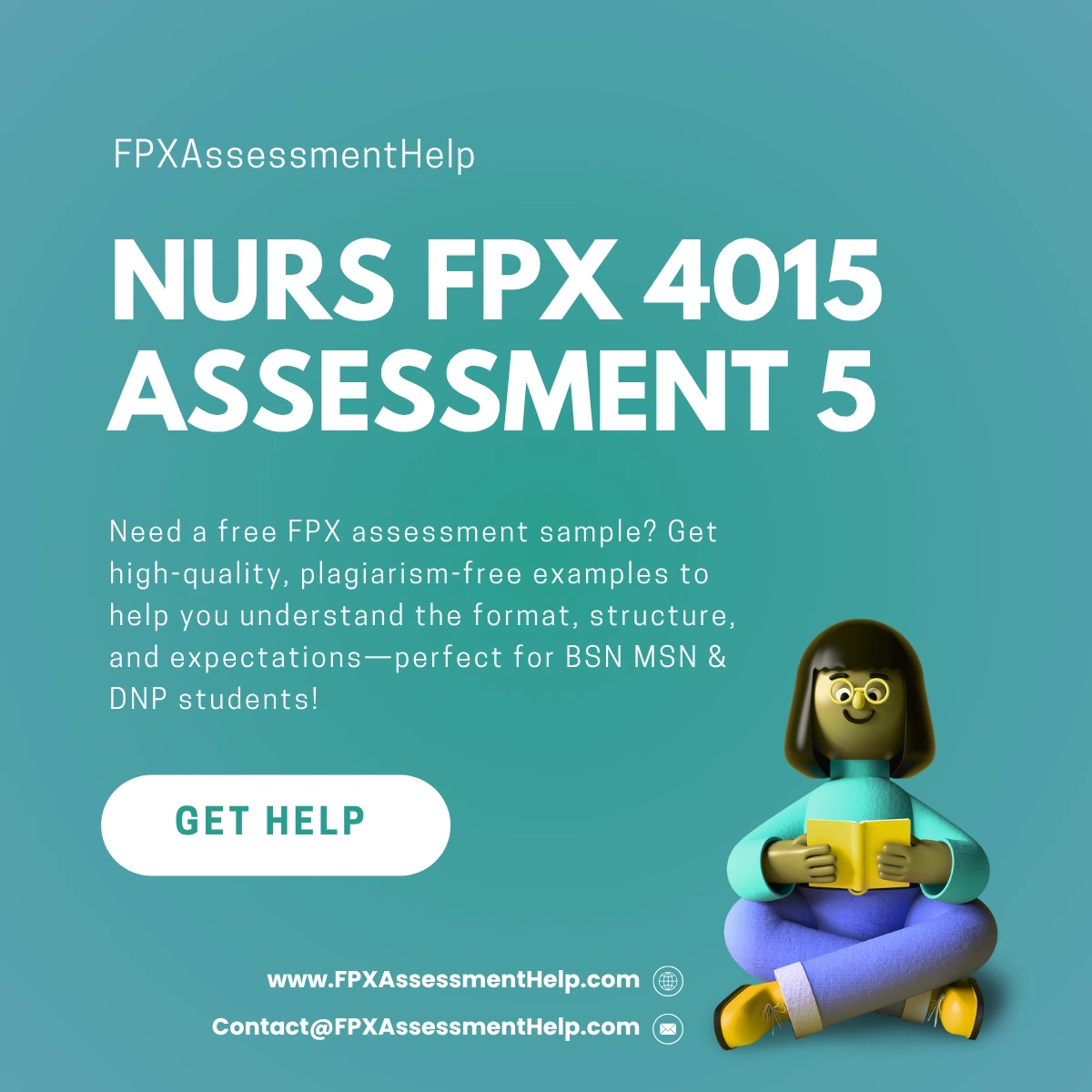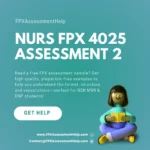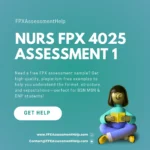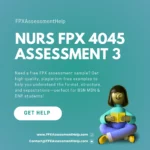NURS FPX 4015 Assessment 5 Comprehensive Head-to-Toe Assessment
Student Name
Capella University
NURS-FPX4015 Pathophysiology, Pharmacology, and Physical Assessment: A Holistic Approach to Patient-Centered Care
Prof. Name
Date
Comprehensive Head-to-Toe Assessment
Good day, Ms. Tehanata. My name is ____ and I will be conducting a thorough head-to-toe assessment to evaluate your overall health status and tailor a care plan specifically for you. Please feel free to let me know if at any point you require a break or feel uncomfortable. Let’s begin the examination.
Comprehensive and Professional Assessment
The initial part of the assessment involves a general observation. You appear alert and oriented to person, place, and time, and there is no immediate sign of acute distress. However, mild dyspnea during conversation is noted, which may relate to your known cardiac condition. Upon taking your vital signs, the readings are as follows: blood pressure is 148/90 mmHg, heart rate is 92 bpm, respiratory rate is 22 breaths/min, and oxygen saturation is 94% on room air. Your body temperature is normal at 98.7°F. These measurements indicate borderline hypertension and a slightly elevated heart rate, likely related to your cardiac profile.
Moving forward, the head and neck assessment reveals pupils that are equal and reactive to light. There is no jugular vein distension observed at a 45-degree angle, and carotid pulses are strong and equal on both sides. Cardiac auscultation indicates a regular rhythm, but with the presence of a soft S3 sound, often associated with fluid overload in heart failure patients. Lung auscultation reveals diminished breath sounds at the bases with fine crackles, suggesting pulmonary congestion.
Abdominal inspection shows a slightly distended but non-tender abdomen with normal bowel sounds in all four quadrants. Examination of the extremities reveals bilateral 2+ pitting edema, diminished peripheral pulses, and pale yet warm skin. Capillary refill time is prolonged at approximately three seconds, which may suggest reduced peripheral perfusion. Neurological screening demonstrates intact motor function, clear speech, and strong bilateral grip, with no observable neurological deficits.
| System Assessed | Findings |
|---|---|
| General Appearance | Alert, oriented, mild dyspnea |
| Vital Signs | BP: 148/90 mmHg; HR: 92 bpm; RR: 22; SpO₂: 94%; Temp: 98.7°F |
| Head and Neck | Pupils reactive; no JVD; strong carotid pulses |
| Cardiac | Regular rhythm, soft S3 sound |
| Respiratory | Diminished base sounds; fine crackles |
| Abdomen | Slightly distended; soft; bowel sounds present in all quadrants |
| Extremities | 2+ pitting edema; pale, warm skin; cap refill ~3 sec |
| Neurological Function | Strong grip; clear speech; intact motor control |
Discussion of Diagnosis and Findings
Based on these findings, there is clinical evidence suggestive of congestive heart failure (CHF). Shortness of breath, peripheral edema, elevated blood pressure, and crackles upon lung examination are all hallmark indicators of fluid overload, likely stemming from impaired cardiac function (Builder, 2021). The presence of an S3 gallop further supports the diagnosis, commonly seen in cases of volume overload associated with heart failure (Williams et al., 2023).
Despite stable oxygen saturation, the constellation of symptoms signifies the need to reassess the current management plan. Potential adjustments, such as modifying diuretic therapy, may help in alleviating fluid retention (Suri & Pamboukian, 2021). It is important that you understand how these clinical findings correlate with your daily experiences—fluid in your lungs causes the breathlessness, while swelling in your legs is due to fluid leakage into the surrounding tissues (Kim, 2022). Strategies such as daily weight monitoring, sodium restriction, and symptom tracking can empower you to manage your condition effectively.
Understanding of Pharmacological Needs
Your symptoms, including edema, shortness of breath, and pulmonary crackles, point toward reduced cardiac efficiency, a hallmark of congestive heart failure. Managing CHF requires not only symptom control but also slowing disease progression. Diuretics, such as furosemide, are often prescribed to reduce fluid overload. These “water pills” increase urine output and relieve swelling and breathing discomfort. However, side effects like dizziness or dehydration need to be closely monitored.
In addition, medications such as ACE inhibitors (e.g., lisinopril) help lower blood pressure and reduce the heart’s workload, while beta-blockers (e.g., carvedilol) are essential for slowing heart rate and providing long-term cardiac protection (Strauss et al., 2021). If kidney dysfunction or drug interactions are present, dosage adjustments and lab monitoring—especially of potassium—will be required.
It’s also important to avoid NSAIDs such as ibuprofen unless specifically approved, as they can exacerbate fluid retention. We will go over each prescribed medication together, provide written instructions, and ensure you feel confident managing your regimen. Your follow-up will include routine checkups and lab assessments to keep your treatment safe and effective.
| Medication Type | Examples | Purpose | Considerations |
|---|---|---|---|
| Diuretics | Furosemide | Reduce fluid overload | Monitor for dehydration, dizziness |
| ACE Inhibitors | Lisinopril | Decrease BP, reduce cardiac workload | Monitor renal function and potassium levels |
| Beta-blockers | Carvedilol, Metoprolol | Lower HR, protect heart function | Titrate dose carefully, monitor for bradycardia |
| Anti-arrhythmics | Amiodarone | Manage arrhythmias | Reserved for specific cases; monitor closely |
| Avoided Drugs | NSAIDs | Worsen CHF symptoms via fluid retention | Should be avoided unless medically justified |
Understanding of Pathophysiology and Clinical Reasoning
Heart failure, in its simplest form, occurs when the heart cannot pump efficiently enough to meet the body’s needs. As cardiac output decreases, blood begins to back up in the lungs, causing symptoms like shortness of breath and pulmonary crackles, especially when lying flat. Fluid may also accumulate in peripheral tissues, leading to leg and ankle swelling. Fatigue is another hallmark symptom, often stemming from reduced oxygenation and nutrient delivery to muscles and organs (Builder, 2021; Kim, 2022).
This condition not only impacts the cardiovascular system but also compromises respiratory efficiency. If left unmanaged, symptoms may worsen and progress to include significant breathlessness at rest, nocturnal dyspnea, and rapid weight gain from fluid retention. These signs demand immediate medical attention and possible treatment modification. Recognizing and responding to early warning signs can prevent hospitalizations and complications.
From a clinical standpoint, the primary priorities in your care plan will involve fluid management, cardiac optimization, rhythm monitoring, and patient education. Diuretics such as furosemide are central in managing fluid overload, while ACE inhibitors and ARBs (e.g., enalapril, losartan) reduce strain on the myocardium and preserve function (Wołowiec et al., 2023). Beta-blockers assist by reducing myocardial oxygen demand and enhancing cardiac efficiency. Arrhythmias, a potential consequence of CHF, will be addressed through vigilant monitoring and treatment with agents like amiodarone if required (Pannone et al., 2021).
Education is equally critical. Empowering you with knowledge on sodium restrictions, daily weight tracking, medication adherence, and recognizing early symptoms can significantly enhance long-term outcomes (Podvorica et al., 2021).
Conclusion
Thank you, Ms. Tehanata, for your cooperation during today’s assessment. Your participation allows us to create a personalized, evidence-based care plan. Our goal is to optimize your health and manage your condition effectively. If you have any questions or concerns, please don’t hesitate to reach out. We are here to support you throughout this journey.
References
Abassi, Z., Khoury, E. E., Karram, T., & Aronson, D. (2022). Edema formation in congestive heart failure and the underlying mechanisms. Frontiers in Cardiovascular Medicine, 9, 933215. https://doi.org/10.3389/fcvm.2022.933215
Builder, V. (2021). Mosby’s pathology for massage professionals – e-book. Elsevier Health Sciences. https://books.google.com/books?hl=en\&lr=\&id=KT1BEAAAQBAJ\&oi=fnd\&pg=PA234
Kim, J. H. (2022). Heart and circulatory system. In Recent Advancements in Microbial Diversity (pp. 229–254). Academic Press. https://doi.org/10.1016/B978-0-12-822368-0.00010-4
Pannone, L., D’Angelo, G., Gulletta, S., et al. (2021). Amiodarone in ventricular arrhythmias: Still a valuable resource? Reviews in Cardiovascular Medicine, 22(4), 1383. https://doi.org/10.31083/j.rcm2204143
NURS FPX 4015 Assessment 5 Comprehensive Head-to-Toe Assessment
Podvorica, E., Bekteshi, T., Oruqi, M., & Kalo, I. (2021). Education of the patients living with heart disease. Materia Socio Medica, 33(1), 10–15. https://doi.org/10.5455/msm.2021.33.10-15
Strauss, M. H., Hall, A. S., & Narkiewicz, K. (2021). The combination of beta-blockers and ACE inhibitors across the spectrum of cardiovascular diseases. Cardiovascular Drugs and Therapy, 37(4), 757–770. https://doi.org/10.1007/s10557-021-07248-1
Suri, S. S., & Pamboukian, S. V. (2021). Optimal diuretic strategies in heart failure. Annals of Translational Medicine, 9(6), 517. https://doi.org/10.21037/atm-20-4600
Williams, J. B., Harmon, D., & Lindenfeld, J. (2023). Physical exam for the presence and severity of heart failure. In Managing Heart Failure in Primary Care: A Case Study Approach (pp. 35–53). https://doi.org/10.1007/978-3-031-20193-6_4
Wołowiec, Ł., Grześk, G., Osiak, J., et al. (2023). Beta-blockers in cardiac arrhythmias–Clinical pharmacologist’s point of view. Frontiers in Pharmacology, 13. https://doi.org/10.3389/fphar.2022.1043714





